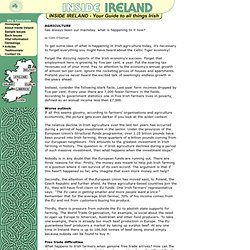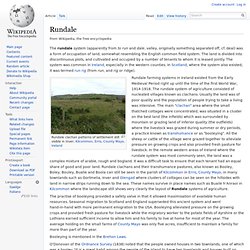

Map2013. Home - Department of Agriculture, Food & the Marine. Inside Ireland. AGRICULTURE has always been our mainstay. what is happening to it now?

By Colm O'Gorman To get some idea of what is happening in Irish agriculture today, it's necessary to forget everything you might have heard about the Celtic Tiger economy! Forget the dizzying reports of the Irish economy's success. Forget that employment here is growing by five per cent. a year. Put the soaring tax revenues out of your mind. Instead, consider the following stark facts.
Worse outlook If all this seems gloomy, according to farmers' organisations and agriculture economists, the picture gets even darker if you look at the wider context. The relative decline in Irish agriculture over the last ten years has occurred during a period of huge investment in the sector. Nobody is in any doubt that the European funds are running out. Secondly, the attention of the European Union has moved east, to Poland, the Czech Republic and further afield.
Firstly, they are getting older. Rundale. The rundale system (apparently from to run and dale, valley, originally something separated off, cf. deal) was a form of occupation of land, somewhat resembling the English common field system.

The land is divided into discontinuous plots, and cultivated and occupied by a number of tenants to whom it is leased jointly. The system was common in Ireland, especially in the western counties. In Scotland, where the system also existed, it was termed run rig (from run, and rig or ridge). Rundale farming systems in Ireland existed from the Early Medieval Period right up until the time of the first World War, 1914-1918. The rundale system of agriculture consisted of nucleated villages known as clachans. The practise of booleying provided a safety valve in that it allowed maximisation of available human resources. Booleying is mentioned in the Brehon Laws. O'Donovan of the Ordnance Survey (1838) noted that the people owned houses in two townlands, one of which was a booley.
Jordan D. 08 May 2008: Address the launch of "A History of Irish Farming 1750-1950" in the National Museum of Ireland, Collins Barracks, Dublin - Department of Agriculture, Food & the Marine. A Chairde Ladiess and Gentlemen I am delighted to have been invited here this evening to the launch "A History of Irish Farming 1750-1950".

I note the following from this hugely important record of the most important sector of the Irish economy so well, written by Jonathan Bell and Mervyn Watson. Most of the landscape of fields enclosed with hedges and walls that we see today is relatively modern, dating from the eighteenth and nineteenth centuries. This book examines the farming systems that produced this landscape.
In the late 18th century, differences in the scale of farming were immense. At the level of medium sized tenant farms on the other hand, we find the earliest evidence for the introduction of new, standardised farm machinery, such as all-metal ploughs, reaping machines or horse drawn potato diggers. Just before the Famine of the 1840s, two-thirds of the Irish population depended on farming for their livelihood. General Conclusions. What is WWOOF Ireland? Teagasc - Contact us. Teagasc organisation.